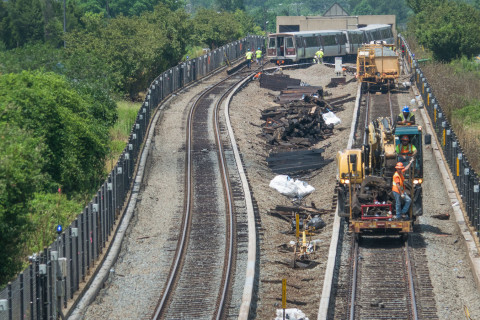WASHINGTON — With a “dysfunctional” organization and “systemic” problems identified by federal investigators who saw staff actively violate safety or other policies firsthand, D.C.’s Metro system and the Baltimore Police Department are facing similar challenges to turn their agencies around and rebuild trust with the public.
Baltimore Police Department’s problems recently were laid bare in a scathing report from the Department of Justice. In Metro’s case, the findings came through a series of investigations from the Federal Transit Administration and National Transportation Safety Board.
The blame game
James Bailey, a professor of leadership and management at George Washington University, said the agencies and their relatively new leaders — Baltimore Police Chief Kevin Davis and Metro General Manager Paul Wiedefeld — have the opportunity to turn things around. They can show they care about the people in the community, as well as the workers, without starting a “witch hunt,” Bailey said.
“This becomes one of the biggest stumbling blocks because everybody is on a witch hunt, [and] everybody is trying to avoid blame. There’s a lot of duck and cover activity … ‘That this isn’t me, it’s them.’ A lot of finger pointing,” Bailey said. “And so it’s often times difficult to get to the source of the issue and to lay down a rational plan for addressing it because of this almost sort-of-paranoia that results from this. A lot of people are afraid they’re going to lose their job here and they’re naturally protecting themselves.”
The Department of Justice report used the word “systemic” 20 times in its report on Baltimore, and cited one case where, even with a federal monitor riding with an officer, a supervisor directed the officer to make unconstitutional stops of black men.
In a statement released after the report, the Baltimore Fraternal Order of Police Lodge 3 said the findings were “disturbing” but said it would not allow the Department of Justice “to lay blame on the shoulders of the dedicated men and women of the Baltimore Police Department.”
“It is a clear indictment of the failed leadership at all levels of city government,” the statement said. “While many will attempt to cast blame on the police officer working the street, the Department of Justice states in their Executive Summary, and we agree, that this failure is the result of ‘systemic deficiencies at BPD.’”
In D.C., the Amalgamated Transit Union Local 689 won at arbitration with an argument that Metro’s problems were so deep that a tunnel fan inspector who was fired, should be reinstated. The inspector was accused of falsifying testing records for fans near the smoke-filled train that led to the death of Carol Glover in 2015.
The arbitration panel found that “discharge may have been warranted but for systemic issues.” The union sued to get Metro to honor the arbitration ruling.
Federal probes
After the investigation into Glover’s death, National Transportation Safety Board Chairman Christopher Hart said safety problems were tied to many different parts of the Metro system.
“From WMATA’s lack of certain safety procedures and its deviation from established ones, this accident reveals a compromised safety system and a dysfunctional organizational culture,” Hart said.
A worker in Metro’s rail operations control center reportedly told investigators that “the right hand didn’t know what the left hand was doing” during the fatal incident.
“Transforming a culture where deviations from the very procedures designed to keep people safe is the norm, to a culture that is intolerant of compromises in safety is a significant challenge for WMATA,” Hart said in spring. “But that kind of change can be done, and it must be done for the sake of all, including me, who ride on this Metro system.”
The FTA released a report in August that found that track inspection and maintenance crews often did not know what they were doing or did not follow up on problems. In response, the union said in a statement that “little has actually changed” in the last decade to change Metro’s safety culture.
In at least two cases, federal inspectors saw Metro workers allow trains to run on tracks that should have been taken out of service for safety. It also found inspections were regularly skipped, that there was pressure or confusion that led to safety failures, and that inspection and maintenance crews are significantly understaffed.
The report and inspections following a derailment in July have led to new changes to Metro’s 24/7 track work plan and additional weekend shutdowns through at least October.
This week, the FTA released another report detailing how maintenance machines and dozens of trains passed stop signals, putting workers and riders at risk, and how, in some cases, trains were coming within a few hundred feet of a collision.
U.S. Rep. Gerry Connolly, D-Va., said in a statement that it was a sign that there is still a long way to go since two trains collided near the Fort Totten station seven years ago.
“I am pleased that FTA acknowledged Metro’s new leadership is making progress in its effort to rebuild a safety culture,” he said. “But this again shows the monumental task ahead of them.”
Brokering a change in culture
Bailey said Metro and Baltimore police need to start with finding the sources of the problems to move the focus from “who is responsible” to “what can we learn.”
“I know this sounds a little touchy-feely, but it’s a completely different attitude that leads to a completely different engagement,” he said.
Any successful culture turnaround would take many years, but it could begin with some small, positive steps.
“Baltimore’s already taking steps to this, and so is Metro — those early victories that are important,” Bailey said. “The problem with the early victories is that oftentimes the vigilance gets lost over a period of time because the pressure, the external pressure, goes away.”
These early victories could mean trouble down the road, Bailey said.
“Reputation has gone up a little bit, things seem to be operating fine, and then all this change, all the excitement that’s been built around it — the urgency that has been present evaporates, and so the thing never really takes root, but rather the problem might end up cycling back again,” he said.
Metro leaders have promised to make significant changes to safety culture before, including after the Fort Totten crash and in other incidents. Demonstrating that the culture has changed could increase riders’ confidence in the system and help reverse a long-term decline in ridership, Bailey said.
Bailey said to make the change takes a “guiding coalition” with power and respect top to bottom to make the changes seem second-nature, and that rewards and constant support for the change emanate from the very top, through the front-line supervisors.
“That involves a … very clear vision: this is what we’re doing, this is why we’re doing it, and this is who we’re going to be when we finish it up,” Bailey said.
“Practice, practice, practice, I mean once people have done it over and over again and been rewarded to it, it becomes the new default, right? I mean in some ways you’re reprogramming people’s brains and their habits and their routines,” he said.






